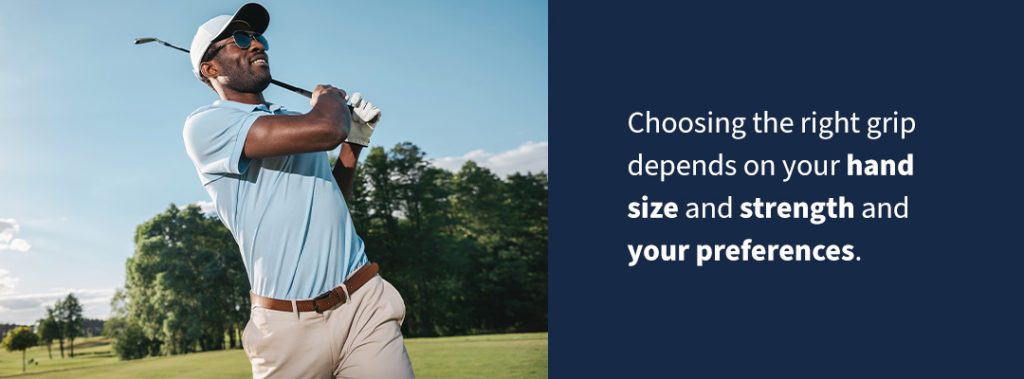

“Golf club grips” refer to how you hold a golf club and the type of grip your clubs have. How you hold your golf club affects your power, accuracy and speed, and grip materials can also enhance your game.
Keep reading to learn popular golf grip styles and what golf grip types you should choose for your clubs. Regardless of where you are in your golfing journey, understanding grips can greatly benefit your game.
When golfers discuss holding a golf club properly, they mention the “lead side” and “trail side.” The lead side is the side of your body closest to the target when you line up to hit the ball. The trail side is the other side of your body that follows the direction your lead side takes as you swing the golf club. For example, for right-handed golfers, the left side of their body is the lead side, and the right side of their body is the trail side.
Here’s a quick review of how to properly hold a golf club:
These basic guidelines apply to every variation of golf grip you can try. Three of the most popular ways to hold a golf club include the overlapping grip, interlocking grip and the 10-finger grip.
This grip is sometimes called the Vardon grip, named after golfer Henry Vardon. It’s a good choice if you have large, strong hands and tend to grip the club too hard.
To try the overlapping grip, place your trail hand pinkie finger on top of your lead hand forefinger when you stack your hands on the golf club. This will help connect your hands so they move as a single unit.
Many famous golfers have used this grip, including Tiger Woods. It’s a better option if you have smaller hands because it combines the strength of your hands into one functioning unit.
To try this grip, interlock your trail hand pinkie finger and your lead hand forefinger when you stack your hands on the golf club. The interlocking grip is known to improve speed and control for some players and can also help you avoid slicing the ball.
Sometimes referred to as the baseball grip, the 10-finger grip is a good option for players who lack strong forearms and want more power in their swings. It’s often recommended for older adults or female players because it provides more power and distance.
This grip involves stacking all 10 fingers in a solid row when you’re gripping the golf club. There’s no layering or interlocking, and it’s important to make sure there’s no space between your hands — your fingers should be stacked right next to each other.
The best golf grip for you depends on what feels most natural and seems to work best. Try all of them out, and then choose one and stick with it. Switching back and forth isn’t recommended since it’s hard to retrain your muscles.

Another important aspect of golf grip is the physical grip that’s present on your golf club. Choosing the right grip depends on your hand size and strength and your preferences. For some players, a smooth grip is more comfortable, while others prefer a grip with lots of texture. Use this golf grips guide to find the best option for you.
Golf grips come in several materials and help keep the golf club in your hands so it doesn’t fly down the green after the golf ball. Golf grips also help you keep control of the clubface so that you can send the ball in the direction you want.
Here are a few types of golf grip material:
The best material depends on your body and the conditions you usually play in. Find a grip you enjoy, and use it for all your golf clubs. When your golf grips are consistent, that’s one less thing you have to think about each time you swing!
The size of your golf grip can also affect your swing. Golf grips come in several different sizes:
If you have large hands, you’ll likely want clubs with standard, midsize or jumbo golf grips. Kids can use junior grips, while adult players with small hands may prefer undersized grips. To make your grip size a perfect match, you can wrap tape around your grip.
When you’re experimenting with grip size, think about how tightly you have to hold the club. Ideally, your grip should be mid-range — you shouldn’t have to hold the club lightly or squeeze it really hard for the club to be comfortable and stay in your hands.
Your golf grip should work for you, not against you. Over time, your grips can wear out and you’ll need to consider replacements. If you’re struggling to control the clubface or the club feels slippery, you might need to replace your golf grips.
Are you looking for a beautiful and challenging course to enjoy this summer? At the Colonial Country Club in Harrisburg, Pennsylvania, you can enjoy a historic green with friends and family. We welcome beginners and advanced players — and everyone in between — and offer golf lessons for those interested in learning the game.
Our stunning private golf course has been in its current location since 1954 and boasts rolling hills and stunning century-old trees. When you become a member, you’ll enjoy access to the golf course, swimming pool and tennis courts. You can also check out our club events to connect with other golfers in our community!
Contact us to learn more and become a member today!